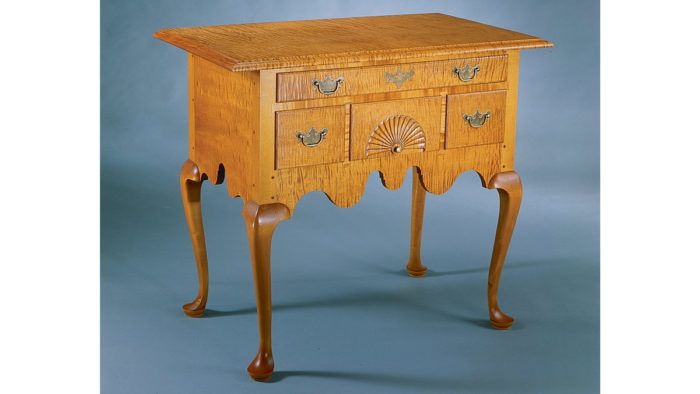
Synopsis: Although not a true replica, this lowboy incorporates the features found on Queen Anne pieces made in Connecticut during the 18th century. The ogee-scrolled apron is reminiscent of the acorn drops found on earlier William and Mary pieces, while the cast brass hardware, typical of later Chippendale styles, was also frequently found on later Queen Anne furniture. This is Norm Vandal’s guide to creating this delicate and graceful lowboy. Sections of the article include: Making the cabriole legs, applied knee brackets, carving the shell, and case and drawer construction.
The Queen Anne dressing table is a rather special woodworking project. The piece itself is beautiful, a lovely example of the fine lines and proportions that characterized the period.
And it is a perfect exercise in all aspects of 18th-century cabinetmaking skills, including mortise-and-tenon carcase construction, sculptured cabriole legs with turned-pad feet, shell carving and drawer dovetailing. When you’ve completed a dressing table, you’ve really made a table and a small chest of drawers, so you will have mastered many of the skills needed to produce other period pieces.
Queen Anne dressing tables actually date back to the first half of the 18th century. They were extremely popular during this period because they are attractive and multifunctional, capable of serving not only as a dressing table, but also as a side or serving table and a basic work surface. Most people today call this furniture form a lowboy, although that term didn’t appear until the end of the 19th century, when it was mentioned in the August, 1899, issue of House Beautiful. Frequently made as companions to matching high chests, called highboys, Queen Anne dressing tables were scaled-down versions of the base on highboys, with all the same features and basic proportions, hence the term lowboy.
The delicate and graceful nature of the lowboy’s form suggests it is a feminine piece. Designed to be placed against a wall, its top is seldom molded on the back edge, as it invariably is at the front and sides. Additionally, the backboard is usually made of a secondary wood, such as pine or chestnut, and is obviously intended to be hidden. The lowboy I’ve designed adheres closely to the essential elements of the Queen Anne period. So while the result isn’t an authentic reproduction, it could well have been an 18th-century New England piece.
For the full article, download the PDF below:
Fine Woodworking Recommended Products

Festool DF 500 Q-Set Domino Joiner

Dubuque Clamp Works Bar Clamps - 4 pack

Bessey K-Body Parallel-Jaw Clamp






















Log in or create an account to post a comment.
Sign up Log in